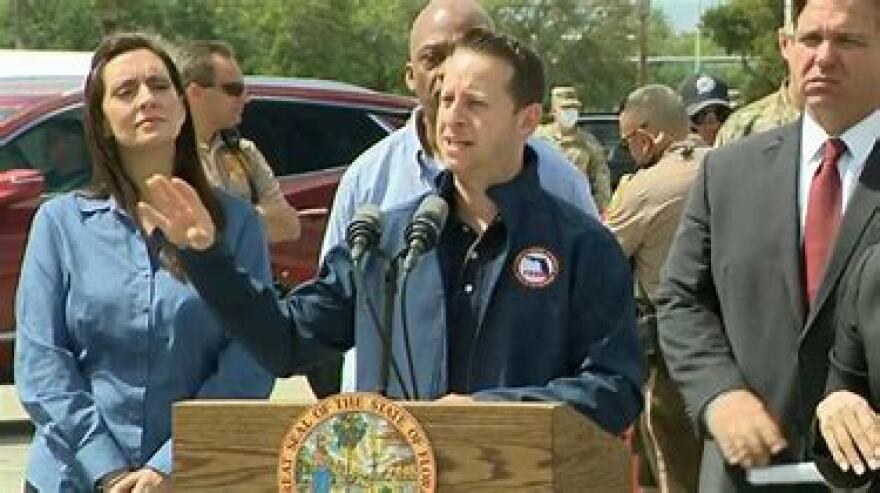With another active hurricane season expected beginning June 1st, Florida emergency management officials are taking into account a massive new factor: the coronavirus.
Speaking last week in Sarasota, Gov. Ron DeSantis said it’s not known how the virus will react a month from now or three months from now; but we have to assume that it’s going to be with us in some capacity.
He added that they’re working with FEMA in preparing for the six-month season.
“How do you do sheltering? How do you do some of these things which are challenging under normal circumstances, but an added challenge when you’re talking about having the introduction of this virus,” said the governor.
“We’re talking to all sorts of different people, because obviously Florida is going to be the tip of the spear on making sure that states are prepared to deal with COVID-19 and hurricane season,” said State Emergency Management Director Jared Moskowitz.
FDEM is redeveloping plans about evacuations and shelters, while also adding facemasks to the state’s stockpile of storm supplies.
“We signed a long-term deal with Honeywell, in which we’re going to get N95 masks right from the manufacturer,” said Moskowitz. “We’re going to get 12 million of those over the next year. We’re making sure that we will have the resources that we need as we get into hurricane season.”

FEMA, says Moskowitz, has been a partner in helping Florida prepare for a coronavirus-era hurricane season. But he adds many questions remain to be answered.
“If we have to do mass-congregant sheltering, what are the protocols that we’re going to put in place? Are we going to have ‘COVID only’ shelters? How are we going to do evacuations? How are we going to limit evacuations? So maybe you have ‘stay at home’ orders for people who live in facilities built to a certain hurricane code based on the hurricane that is approaching? All of these options are on the table.”
Working to come up with some local answers is Escambia County Emergency Operations. Director Eric Gilmore says they’re now in the planning stages of sheltering, and are awaiting guidance on a proposal of 110 square-feet of shelter space per person.
“Our planning numbers are typically around 12,000 people in a shelter — 20 square-feet per person — and we have six shelters identified that meet that need,” said Gilmore. “But if we have to go to 110 per square-feet per person, we’re looking at 29 shelters. And that’s still not meeting the square footage requirement.”

For now, the thinking in Escambia County is for around 50 square-feet per evacuee, to accommodate a form of social distancing for pockets of families.
“We’re also trying to procure masks and hand sanitizers, so that we have enough PPE in the shelter,” Gilmore said. “Everybody understand, that this is an emergency-type situation; 72 hrs. [after a storm] and then we try to get to a host sheltering, where we can space everybody out.”
Bottom line, says Gilmore, is that people need to know that despite threats from storms, COVID-19 is still out there, and they may be in a crowded shelter with people they don’t know. He urges everyone to get a plan to protect yourself from both.
“Try to avoid a shelter at all costs and let that be a shelter of last resort for you,” said Gilmore. “That’s what the message is going to be this season. If you’re uncomfortable or you’re worried about COVID-19, it’s just going to be tough to accommodate a large number of people in an emergency evacuation shelter with the square footage.”
Since Hurricanes Ivan and Dennis in 2004-05, many houses in the Pensacola area have undergone hardening against future storms. Gilmore says if your home is one of them, you could very well already be in your hurricane shelter.
“There’s been a lot of mitigation money out there through the years, replacing and hardening structures; the main message is going to be ‘If you feel your house is hardened, stay in your hardened shelter,’” said Gilmore. “We always want to run from the water, and hide from the winds. So if you’re not in an immediate storm surge zone and you do have a resilient enough structure, that would probably be the best bet for you.”
This year the average forecast — for all 13 groups that have submitted to Seasonal Hurricane Predictions — is eight hurricanes and 17 named storms. An average season sees six hurricanes and 12 named storms. One unknown is El Nino, but some experts contend that the Pacific phenomenon will not inhibit hurricane activity this year.

